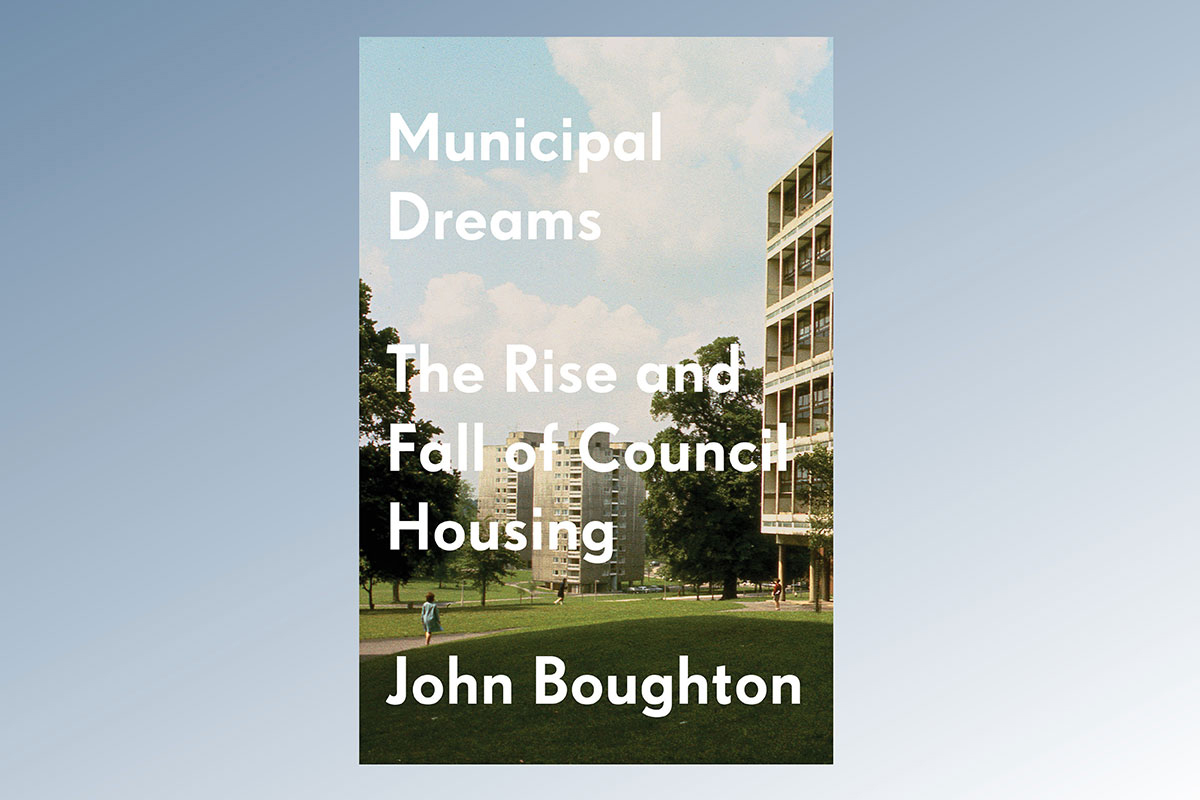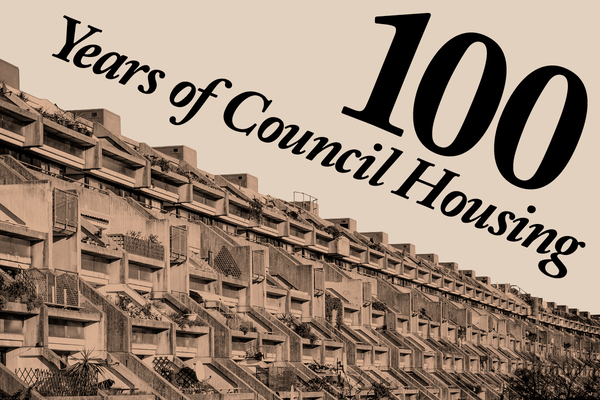The Rise and Fall of Council Housing
To mark its paperback release, we are republishing the below extract of acclaimed history book Municipal Dreams: the rise and fall of council housing. Here, author John Boughton explains how council housing became “welfarised”
A new book by John Boughton traces the history of council housing from its origins in 19th century Liverpool and London, to slum clearances, the Right to Buy, right up to the present day disputes over regeneration and concerns over safety following the Grenfell Tower fire.
"Muncipal Dreams: the rise and fall of council housing" also provides description of some of the most well-known housing estates and the story behind them.
In an extract from the book below, Mr Boughton argues that housing polices in recent years have led to the ‘welfarisation’ of council housing, which had one time been used to house affluent people.
The below extract was first published by Inside Housing on 9 May, 2018, to mark the hardback release of Muncipal Dreams:
Looking back at council housing’s history, we saw how in its early years it housed a relatively affluent working class, those in steady employment who could be reliably expected to pay its comparatively high rents.
In this sense, councils were like any other landlord: they wanted ‘respectable’ tenants for their housing and a guarantee that its capital costs would be paid off and running expenses met.
This should remind us that council housing is not, in any meaningful sense, ‘subsidised’.
Construction loans are repaid and, in most cases, the homes themselves become an asset, not only to those who live in them but a financial – and income-generating – asset to the local authority. To those to whom council housing did not cater – the ‘submerged tenth’, the ‘residuum’, the casually employed, low-waged or unemployed slum working class, a ‘filtering up’ theory was applied.
“Council housing is not, in any meaningful sense, ‘subsidised’"
They, it was hoped, would move into the slightly less slummy housing vacated by their immediate superiors.
This changed, but changed slowly.
Slum clearance in the 1930s combined with the impact of the Great Depression brought a poorer working class into council housing for the first time, and with it some of the perceived problems and demonising stereotypes applied to council tenants more generally in recent years.
The policy shift reflected a political division between Conservative politicians who believed council housing should properly be reserved for the neediest (the market would provide for the rest) and those on the left who saw it as serving ‘general needs’.
Full employment and rising living standards after the Second World War reinvigorated the sense that council housing catered predominantly for a relatively prosperous and aspirational working class. But, from the 1970s, politics and economics combined to lower its status and that of its community. The National Rent Rebate Scheme implemented in 1973 (it became housing benefit in 1982), increasing access to council housing for the less well-off, was a significant factor in the shift.
The 1977 Housing (Homeless Persons) Act, prioritising council housing for the most vulnerable and cementing a system of needs-based allocations, was central to it.
“Politics and economics combined to lower council housing’s status and that of its community.”
Right to Buy and the near cessation of new build in the 1980s was determinant.
The concomitant collapse – or destruction – of the traditional manufacturing economy and loss of jobs that went with it was, in this context, just a bonus.
All that made for, in one word, residualisation: the increasing confinement of council housing (and by this time social housing) to the poorest of our citizens and, disproportionately, those classified as ‘vulnerable’ in some way. (That estates continued, in fact, to house a cross-section, albeit a narrower one, of our community goes without saying.)
In the 1980s, residualisation may have been a partly unintended consequence of housing policies pursued with varying ideological intent.
Since 2010, and more so since the return of single-party Conservative government in 2015, we’ve seen something further: welfarisation – ‘a conception of social housing as a very small, highly residualised sector catering only for the very poorest, and those with additional social “vulnerabilities”, on a short-term “ambulance” basis’.
To some extent, this replicates the agenda of Conservatives in the 1930s and, with Harold Macmillan’s abolition of the ‘General Needs’ subsidy in 1954, it represents in its present form something deeper and more dangerous. In the years after 1945, we talked first of ‘social security’ – a universalist provision protecting all sections of the populace.
Now we use the language of ‘welfare’ adopted from the US and with it all the freighted notions of the scrounging underclass popularised by TV exposés of those on benefits.
From this perspective, those who need social security – I would say ‘depend’ on it but for the political use of the term ‘dependency’ to signify some failure of will and character – are placed on society’s margins and stigmatised.
‘Council estates’ – the preferred term for the negative connotations it carries despite the huge changes in the social housing sector – take their place in this dystopic pantheon. The practice of welfarisation has taken a number of forms.
“Now we use the language of ‘welfare’ adopted from the US and with it all the freighted notions of the scrounging underclass popularised by TV exposés of those on benefits.”
The practice of welfarisation has taken a number of forms in recent years, but perhaps the most powerful has been the attempt to end lifetime security of tenure for those living in social housing, made first by the Conservative-Liberal Democrat coalition government in office from 2010 to 2015 and latterly by the Conservatives alone.
Technically, lifetime security only came into place in 1980 – a by-product of Right to Buy. The understanding was always that tenants who paid their rent, and otherwise behaved responsibly, enjoyed a home for life though they have, of course, always been subject to eviction for breaches of their conditions of tenancy.
This in itself, to ideologues of the Right, was a form of dependency, inhibiting the ambition and social and geographical mobility appropriate to citizens of a free market.
To others, and I remember the late social scientist and geographer Doreen Massey, raised on the Wythenshawe Estate, making this point eloquently at a housing conference, it has offered precisely the security which has enabled their lives to flourish.
In presenting the 2011 Localism Act which empowered social landlords to offer ‘flexible’, fixed-term tenancies of two to five years in duration, however, ministers offered apparently more pragmatic arguments. (Housing associations already had the right to offer assured short-term shorthold tenancies but this was hedged by the requirement that they also ‘offer and issue the most secure form of tenancy compatible with the purpose of the housing and the sustainability of the community’.)
It was, the then housing minister Grant Shapps suggested, ‘no longer right to require that every social tenancy should be for life – regardless of the household’s particular circumstances’.
Critics pointed to the irony that the threat of losing a council tenancy through an advantageous change of circumstance (new-found employment or a better-paid job, for example) might be a disincentive to precisely the enterprise the legislation was supposed to encourage.
“The practice of welfarisation has taken a number of forms in recent years, but perhaps the most powerful has been the attempt to end lifetime security of tenure for those living in social housing.”
Shapps claimed too that the bill gave councils and housing associations more freedom in managing their housing stock and would allow them, in particular, to address the problem of under-occupancy – the fact that some tenants had more bedrooms than their needs apparently warranted. The latter was not something viewed as a problem in owner-occupied homes, but in the case of social housing the stated aim, as Shapps argued, was to ‘create a more flexible system so that scarce public resources can be focused on those who need it most’.
The thinly veiled implications of this – that the homes of social housing tenants were regarded as a gift to be granted or withdrawn according to higher interests and that the sector as a whole be reserved to the neediest – hardly need highlighting.
Some of the more aggressively proactive housing associations welcomed the scheme, those labelled by the housing academics Suzanne Fitzpatrick and Beth Watts as either ‘interventionists’ (keen to ‘improve’ their tenants and move them on and up) or as ‘utility maximisers’ (wanting to manage their stock as efficiently and as commercially as possible).
More traditional housing associations and Labour-controlled local authorities were generally hostile, while flagship Tory councils such as Wandsworth and Barnet embraced the legislation and its underlying ethos.
Overall, however, by 2015 only some 15 per cent of new general needs tenancies were being offered on a fixed-term basis.
This was clearly the wrong sort of ‘localism’ and, after the 2015 general election, a newly unfettered single-party Conservative government proposed in its 2015 Housing and Planning Bill to compel the use of fixed-term, two-to-five-year tenancies for nearly all new council house lettings. Powerful opposition in the Lords forced concessions.
For certain groups such as older and disabled people, the maximum tenancy period was raised to ten years and it was also accepted that secure tenancies should cover the full period of a child’s schooling to the age of nineteen.
These were concessions which, although confined to those judged ‘vulnerable’, confirmed practically the arguments made by those who opposed short-term tenancies more broadly: that it was precisely the security and stability of so-called tenancies for life which enabled individuals and communities to grow.
“Critics pointed to the irony that the threat of losing a council tenancy through an advantageous change of circumstance (new-found employment or a better-paid job, for example) might be a disincentive to precisely the enterprise the legislation was supposed to encourage.”
Another component in the Conservatives’ welfarisation agenda came with ‘Pay to Stay’.
Again, it came with a ‘common sense’ proposition – that it was ‘simply not fair that hard-working people [were] subsidising the lifestyles of those on higher than average incomes’.
Even better, it came with a suitably (in government terms) ugly face – the late Bob Crow who, as the ‘union boss’ of RMT, was making life difficult for commuters while earning a six-figure, executive salary and living in a council house.
The Telegraph reckoned there were 5,000 others earning over £100,000 similarly placed – an impressive example of council homes promoting social mobility, you might think, though in truth the figures are dubious.
The initial plan, announced by Chancellor of the Exchequer George Osborne in the July 2015 Budget, was straightforward: social housing households earning over £40,000 in London and over £31,000 elsewhere in the country would be required to pay the equivalent of local private sector rents.
The Tory-controlled Local Government Association – alongside most working in the housing field – provided the obvious retort: first, that such incomes (particularly where there was more than one breadwinner or a number of dependent children) couldn’t properly be considered high-earning; and second, that the proposed rules disincentivised ‘hard-working people’ and those aspiring to earn more.
A study commissioned by the association concluded that the policy would hit 214,000 households across England and that up to 70,000 – unable to afford the new rent levels – would be forced to leave the homes and areas in which they lived.
By October, the new Housing Minister Gavin Barwell was suggesting that a tapered system (in which rents rose more gradually in line with incomes) might operate to offset the undeniably drastic effects of the original ill-conceived proposal.
One year later, the scheme was scrapped; councils and housing associations were to be given discretion.
The government had listened, Barwell claimed. In reality, practicalities had, for once, outweighed ideology.”
Municipal Dreams: the rise and fall of council housing by John Boughton is published by Verso Books and is available now on hardback.
A review of Municipal Dreams: the rise and fall of council housing
Eagerly anticipated, well publicized and timely.
This book by blogger John Boughton sets out to tell the story of the history of Council housing from the Victorian period to today.
Clearly Londoncentric, it is a thought provoking work from someone who is knowledgeable enough to tell the story, whilst avoiding the approach from a political viewpoint.
This from a self-acknowledged Labour foot soldier in the Thatcher years it is no mean feat in itself. The major provincial cities are recognised, often a few paragraphs, sometimes one paragraph and occasionally just a sentence.
Bizarrely Carlisle and Hull feature more than one might expect, even more bizarre, Walsall is awarded City status.
Liverpool gets several entries over the years, but no mention of the Housing Action Trust success, whilst Hull’s Housing Action Trust is given real prominence.
“The book will become a standard tome for students, academics and practitioners alike”
But the emphasis on London will remind the reader of the way Council housing was influenced by the architectural whim and fancy of the time, often copied from abroad, visionary planners, and a political desire to achieve something for the working classes, in the early days too expensive for them.
Quickly in the early chapters, Boughton skims over the first 50 years of the twentieth century, giving time for a more detailed analysis of real attack on those post WW2 evils of slum clearance, overspill developments, shoddy building and ultimately the decline of Council housing as it fell from grace and ambition.
Bringing the story up to date, the references to Grenfell, the short months between Prime Minister Cameron promising to “blitz”poverty by demolishing the country’s 100 worst estates, appointing Heseltine to swing the demoition ball, Brexit and his fall from grace, taking with him yet another initiative all add to a fascinating story.
The book shows how the whole history has been impacted by war, initiatives, subsidy both capital and revenue and how housing associations came to fill a gap, but now seem themselves to be devoid of the will to house those most in need.
The book is both a good buy and worthy of a prominent place on a bookshelf. It will become a standard tome for students, academics and practitioners alike.
It should be required reading for Jeremy Corbyn, John Healey and whoever is the Conservative Housing Minister this week.
Rodney Dykes, managing director, Bee Housing
100 Years of Council Housing: we want to hear from you
To mark the 100th anniversary of the act receiving Royal Assent in July, we have a month of special activities planned, including interviews with senior council housing figures, exclusive debate and comment, and investigations into what local authorities, past and present, are doing to help provide housing.
This will signal the start of a stronger focus on local authority housing issues over the coming months on www.insidehousing.co.uk and in our weekly print and digital editions.
We want to hear from you about your local authority is doing to mark the Addison Act and about the housing issues in your area, email: editorial@insidehousing.co.uk
Sign up to receive the latest housing news straight to your inbox through our exclusive Council Focus bulletin
If you are already a subscriber click here to manage your newsletter sign-ups
Click here to read more about our activity to mark the Addison Act
More on the Addison Act
How George Clarke is aiming to end the housing crisis with his new TV show Architect George Clarke has long been a passionate campaigner for more – and better – council housing. As Inside Housing celebrates 100 years of the Addison Act, Martin Hilditch meets a man on a mission
100 Years of Council Housing: your tweets from week three Our favourite #100yearsofcouncilhousing tweets from the past seven days as our Addison Act activity moves into its fourth week
Nottingham's new wave Robyn Wilson goes to Nottingham to see what the next generation of council homes are set to look like.
If we’re going to have another 100 years of council housing, Right to Buy has to go The Right to Buy is having a devastating effect on the availability of council housing in this country and must be scrapped, writes Lee Sugden
What next for council housing? To celebrate the centenary of the Addison Act, Inside Housing asks a group of housing experts what can be learned from its legacy (sponsored)
Thatcher's legacy: a brief history of the Right to Buy An engine for social change or a handbrake on council development? We look at why the Right to Buy is as divisive as ever #ukhousing
A history of council housing: a timeline From the Addison Act to prefabs, slum clearance and the Right to Buy, council housing in the United Kingdom has a long and colourful history. Carl Brown looks at how it has evolved over time
Council housing: the key to a more equitable and dynamic society As the 100th anniversary of the Addison Act approaches, we publish an abridged extract of a book by Chris Matthews chronicling the history of council housing in Nottingham
Addison’s framework was scrapped but its legacy is more important than ever The fortunes of council housing have ebbed and flowed ever since Addison’s programme was abruptly halted in 1921, writes Jules Birch
Hulme: the redevelopment project that changed regeneration The redevelopment of Hulme in Manchester kick-started a new approach to regeneration in the UK – and the careers of some of housing’s best-known figures. Martin Hilditch joins them on a step back in time with lessons for today.
100 Years of Council Housing: your tweets from week two We pick our favourite #100yearsofcouncil housing tweets over the past week
Memories of council housing: the human legacy of the Addison Act As the centenary of the first council houses approaches, Peter Apps hears from some of the people who have lived in them in the decades since
Many of the sector’s current leaders began their journeys in council teams One hundred years of council housing has delivered a generation of sector leaders as well as millions of council homes, writes Mervyn Jones
Stevenage: home of the new town revolution Stevenage was the first of the post-war ‘new towns’. Gavriel Hollander visits the town to see how it has changed.
100 Years of Council Housing: your tweets from week one Inside Housing has been encouraging councils to say what they are doing to build homes and to mark 100 years of council housing. Here we feature a selection of your tweets
Kit Malthouse: 'Council housing is coming back with a vengeance' Housing minister Kit Malthouse tells Martin Hilditch why growing numbers of councils are looking to get back into development
Sea Mills: we visit one of the first estates to benefit from the Addison Act Social historian John Boughton visits a place in Bristol still cherished today
The Housing Podcast: is council housebuilding about to make a comeback Nearly 100 years after the introduction of the Addison Act, which kick-started the building of the first council estates in the UK, the Housing Podcast team examines the state of council housebuilding today
Why the 100th anniversary of the Addison Act should spark a council housing comeback Let’s make 2019 the start of a renaissance of council housing, writes Martin Hilditch
Are new borrowing freedoms sparking a revival of council housebuilding? The Addison Act marked the birth of council housebuilding. A century later, could recent financial freedom spark a renaissance? Nathaniel Barker investigates.
How Cornwall is taking inspiration from Christopher Addison Cornwall Council is one of many keeping the legacy alive, writes Kate Kennally.
The Addison Act - celebrating 100 years of council housing This year marks the 100th anniversary of the Addison Act – which paved the way for council housebuilding on a large scale. Inside Housing has a whole month of special activity planned and we want to hear your stories
The 100-year anniversary of the Addison Act means it’s time to talk about council housing Let’s use the 100th anniversary of council housing as we know it to flag up some of the great work that’s been done – and kick-start a conversation about the future, writes Martin Hilditch
London must recapture the housebuilding ambition of the Addison Act Councils are committed to development but are still facing unfair restrictions, writes Darren Rodwell of London Councils
Marking 100 years since the ‘Addison Act’ Professor Mark Swenarton writes about the Homes Fit for Heroes Centenary Conference
100 Years of Council Housing: what Inside Housing is doing
One hundred years ago, a piece of legislation led to the birth of council housing. Gavriel Hollander introduces Inside Housing’s celebration of the centenary of the Addison Act.
It is so ingrained in our national consciousness that it is hard to imagine just how radical the idea of local authority built and funded housing must have seemed a century ago. Before World War I, almost all housing in the UK was built by private developers (albeit with some notable municipal exceptions in major cities). Given this, it is unsurprising that both quality and consistency of delivery were variable.
The post-war introduction of subsidies for councils to solve the blight of slum estates was supposed to right a wrong and – in the words of then-prime minister David Lloyd George – provide “homes fit for heroes”.
The so-called Addison Act – the very first housing act passed in this country, named after its sponsor Dr (later Lord) Christopher Addison – received royal assent exactly 100 years ago this month.
It may never have achieved its aspiration of delivering 500,000 homes (something that may sound familiar to modern-day watchers of government housing policy) but it was the start of a movement.
New estates began to crop up across the country, built in accordance with recommendations from the Tudor Walters Report, which was produced to parliament in November 1918. This built on the ‘Garden City Principles’ and suggested a number of improvements to the standard of public housing. These included limiting the length of terraced-housing blocks, mandating a minimum number of rooms and providing indoor bathrooms.
“The post-war introduction of subsidies for councils to solve the blight of slum estates was supposed to right a wrong and – in the words of the prime minister David Lloyd George – provide ‘homes fit for heroes’”
Although the abandonment of subsidy in 1921 and a change of government the following year curtailed the immediate growth of council-built housing, the seed had been sown.
This month Inside Housing celebrates the centenary of the Addison Act with a month-long series of articles looking at how it transformed the social fabric of the country and created the housing sector we know today.
Over the course of this month, we visit four estates, each symbolising a different era of council housebuilding. We also take a look at whether new-found financial freedom for local authorities could be the catalyst for a new generation of estates.
To kick off the series, acclaimed social historian John Boughton visits one of the first estates made possible by Lord Addison’s historic legislation: Sea Mills in Bristol. We then travel to Stevenage to look at how the damage to Britain’s inner cities during the Blitz led to the new town movement and a fresh wave of estates through the 1950s and 1960s.
Martin Hilditch, editor of Inside Housing, takes a trip to Hulme in Manchester to examine how the private and public sector had to work together in the 1980s to deliver a regeneration project, which is still thriving more than 30 years later.
Finally, we go to Nottingham and look at one council with grand ambitions to provide housing to a new generation of tenants.
There may still be myriad challenges to face when it comes to providing good-quality, genuinely affordable housing for those most in need, but without the passing of an act of parliament 100 years ago, the sector we work in today may never have come to exist. That alone is worth celebrating.
To read more about the act, go to: www.insidehousing.co.uk/AddisonAct
More council news
Council tenants on Universal Credit 16 times more likely to abandon tenancies
Council to claw back 260 Right to Buy homes
Local authorities accuse government of ‘sleight of hand’ over post-Hackitt regulation
Partner with housing associations to use borrowing freedoms, says LGA chair
Bristol City Council signs off partnership with L&G for 500-home scheme
Council boss warns against local authority ‘can't do’ attitude towards housebuilding
Right to Buy sales plummet 23%
Supreme Court rules against Birmingham Council in homelessness case
A bed every night: has Manchester's mayor succeeded in helping every rough sleeper in the city?
Council housing company to offer Rent to Buy
Council-owned regeneration company to build 500 homes
How has Haringey Council moved on from its development vehicle fight?
Liverpool to open HRA to build new council homes for first time in 30 years
How can London councils build more homes?
Birmingham Council’s housing company to build 2,708 homes by 2029
How are councils are using pension funds to build homes














